How much does it cost to get a decent .22 “plinker,” or whatever youd like to call a .22 pistol for shooting fun in camp or on the trail? Can you get one for under $150? Or will you have to spend many hundreds of dollars? The answers may depend on your proposed use for the gun, but if we limit the use to simply having low-cost fun with a semiauto handgun, the ground has been laid for our current test.
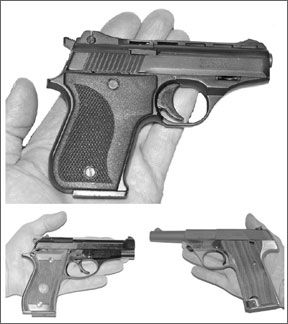
We came across a low-cost pistol at a local gun store, the Phoenix HP22A ($140 locally) and could not believe it would be any kind of performer, our opinion being based largely on its extremely low price. We had on hand a more costly pistol by a top maker, Berettas Cheetah Model 87, with a price tag ($675) well over four times the cost of the Phoenix. Both pistols seemed intended for casual shooting. They were certainly not target pistols, and too small for serious self defense. We decided to try these two against each other, and then threw in a recently made High Standard Sport King ($695).
Our impression of the Sport King was that although it was larger than the Beretta and much larger than the Phoenix, it seemed to be designed for the same casual uses of the other two, with its fixed sights and Parkerized finish. Its cost indicated it ought to do a pretty good job of busting apart yonder tin can. Heres what we found.
Phoenix HP22A
.22 LR, $140
Inside the cardboard box we found a compact, comfortable, good-looking little pistol with enough heft and size to give it a reasonable feel. It came with a comprehensive owners manual, and because the operations of the gun were different from what were used to, our first step was to read that manual. Part of it bears repeating:
“Do not put ammunition into this pistol… until you fully understand all [its] functions….” We recommend all Phoenix buyers follow that advice not because the gun is dangerous, but because doing so will avoid frustration along the way.
The frame, slide, and barrel housing of the single-action Phoenix are made of non-magnetic material, presumably zinc castings, but with steel inserts at appropriate locations, such as within the barrel, on the breech face, and where the slide presses against the hammer to cock it during ejection. Most internal parts are steel. Before you reject this gun out of hand, note that this is a similar concept to putting steel inserts into plastic guns, as done by Glock, Ruger H&K, and a host of others. Is plastic stronger than zinc alloy?
The sight picture was exceptionally good. The squared front blade was serrated or notched to cut glare, and the rear blade had adequate width to its notch to let the sights work well and quickly. A detented screw gave windage adjustment to the rear blade. However, the gun was perfectly sighted, and we moved the blade only to get a feel for how it worked. The finish was black paint, and the grip panels were checkered plastic. There was a vented rib along the top of the gun. The external hammer was easily cocked. The slide had good serrations that made it easy to operate.
There were what appeared to be two safeties. However, the one on the slide, with its red dot, was only a firing-pin block. For most of our shooting we put it into the firing position and ignored it. The real safety was at the top of the left grip panel, and operated almost normally. When it was in the Fire position, you could not remove the magazine. Press it up to Safe, and the ten-round mag drops free. This safety button could also be used to lock the slide back, though that didnt happen when the magazine ran empty. With the button in Safe, you could not rack the slide fully, but could check the chamber easily. Neither could you cock the hammer, nor drop it, with that button shoved upward. Once all the operations were fully understood, they all made perfect sense and became second nature to us. Our test shooters did not do any fumbling with the gun once its operations were all made clear.
The instructions for the Phoenix recommended only standard-velocity ammunition. We chose to follow that recommendation with one exception. We tested all three guns with three standard-velocity loads, Remington Rifle Target, Federal Match, CCI Pistol Match, and the high-velocity exception, Winchester Super-X Power Point hollow points.
On the range we found it quite easy to load the first seven shots into the ten-round magazine, easier even than the Beretta. However, we had to work hard to get in the last three rounds. In fact, we noticed a bit of stickiness chambering the first round from a full magazine. Wed load only eight or nine rounds if we owned the Phoenix, and our fingers would thank us. The Phoenix went right to work. The sights were on the money, and the little gun made decent groups dead center at 15 yards. In the course of our testing, the groups seemed to be getting smaller. The trigger pull was clean, reasonably light, and gave good control. The rounds all fed, right from the start, just like they were supposed to. In all our limited testing we had no failures to feed, fire, or eject, other than having the help the slide go forward on occasion with ten rounds in the mag.
Takedown was very easy, though reassembly was not quite so easy. The manual had excellent reassembly instructions. We had a harder time putting the Beretta back together.
Beretta Cheetah
Model 87 .22 LR, $675
The good looks and fine workmanship of this pistol were seductive,
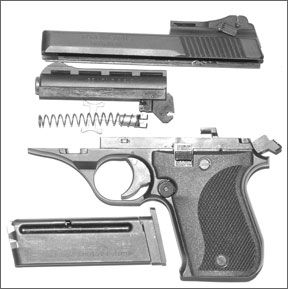
and we almost fell for it. The slide and barrel were steel; the frame, aluminum. The control buttons were all steel. The general look reminded us of a streamlined version of the old Beretta Model 948, missing only the finger hook on the bottom of the mag. Both had the open-top slide, burr hammer, and cut-in front to the slide. Both old and new versions have inherent designs that would tend to limit accuracy. The barrels are not rigidly attached to the frame, and can work loose over time. The slide holds the sights, so they can move with relation to the barrel from shot to shot. Neither the 948 nor the Cheetah will ever be a target pistol. But we expect the Cheetah to keep shooting a long time. The care in its manufacture was evident everywhere.
The gun had superb machining, polishing and bluing. It was all nicely finished, well fitted, and had good-looking checkered walnut grips. The sights were easily seen, a three-white-dot setup, and the sight picture was excellent. The front blade was integral with the slide. The square-notched rear was staked in place. It could be drifted for windage, and needed a touch of adjustment, but we left it alone.
The double-action pull was smooth and useful. We liked the SA trigger, too. The gun felt good, was hand-filling, and not too heavy. The Beretta website (www.berettausa.com) says the Cheetah magazine holds only seven rounds, but our sample held eight, still somewhat of a disappointment. The slide stays open
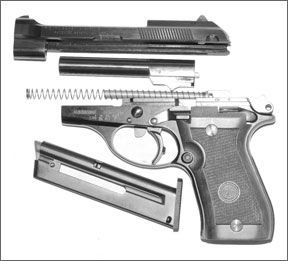
after the last shot, and the gun could not be fired with the mag out. We found the magazine not all that easy to load. We also found it hard to put the safety on without using the weak hand. The safety was ambidextrous, and easy enough to move to the firing position. The serrations made slide manipulation easy. Of course the huge slide opening gave empties an easy way out. We found a design feature we didnt like, and shooters need to be aware of it. We habitually load a fresh magazine with a firm motion to ensure it seats fully. With the Beretta, the shock of seating the magazine would drop the locked-open slide on a fresh round. Buyers need to be aware of this.
Takedown was very easy, although the four-language instruction book gave incorrect information. Unload the gun, press the takedown levers locking button on the left side of the frame toward the right, then rotate the takedown lever (on the right side) 90 degrees. Move the slide forward off the frame. Carefully remove the slide spring and its guide from their recess in the barrel, and thats it. We found it very difficult to get the slide spring and guide back into place beneath the barrel. The manual gave zero information on this. It appeared the front of the guide rod needed to be chamfered or slightly rounded to ease reassembly.
High Standard Sport King
Model TX 9200 .22 LR, $695
The High Standard Sport King was attractive and comfortable to handle. It was a bit larger than the Beretta and promised better
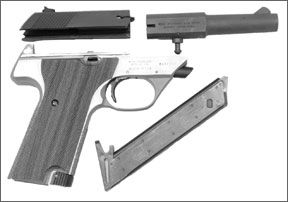
accuracy, if for no other reason than the brands history of producing excellent target pistols on a par with the fabled S&W Model 41. The overall appearance was attractive. The entire gun was nicely Parkerized, but the sides of the frame were polished to bare steel that tended to glare in bright sunlight. The grip panels were beautiful, fully checkered fancy wood. The front and rear steel grip straps were nicely stippled in a most useful way that, overall, gave comfortable and secure control to the gun.
The grip felt very familiar to those who shoot 1911s. The size and angle were nearly identical to the ol .45. Yes, that makes it a bigger gun than necessary, and many would like to see an even shorter barrel. The only barrel option is a longer one at 6.75 inches. Those who love the 1911 will be right at home here. They can use this .22 for some 1911-handling practice, because the safety was in the same approximate position as that on the 1911.
Earlier models of the Sport King, out of Connecticut, had a more slanted grip. The earlier versions also had a more abrupt line at the rear of the slide/frame junction. We liked the looks of this one much better. In fact, from a brief look at the new companys website (www.highstandard.com), the old highly slanted grip style is now long gone. All the new guns feature this 1911-type grip shape.
The High Standard came with only one 10-round magazine. There was a brief but adequate set of instructions, and a separate sheet with the suggestion the owner make a search for the best ammo selection for the Sport King. That makes perfect sense. But we also received a verbal notice (indirectly) from the factory that this gun had a tight chamber. It was therefore recommended that we use target-type ammo in it to be sure it would all fit the chamber. The barrel was apparently a surplus part marked as having been made in the old Hamden, Connecticut, factory, which would mean this barrel has been around a long time. On close inspection we found traces of pitting on the barrels exterior surface. A casual glance through the bore showed a shiny surface, but under the glass it was rough inside near the muzzle. It turned out the barrel leaded at the muzzle on the rough spots, killing finest accuracy.
The frame was identified as having been made at the Houston, Texas, facility. If this gun truly had a tight chamber, we thought, that defies logic for a pistol intended for the field. It seems to us such a pistol should be able to use all the higher-powered .22 LR loads, which are designed for field use. In our tests, the chamber accepted a wide variety of high-speed ammo with only an occasional sticky round, so if it was a tight chamber it didnt seem to make much difference.
The trigger pull was outstanding, crisp and clean at 3.2 pounds. The sight picture was excellent. The fixed rear sight could be drifted for windage, and was slanted rearward to give a clean picture at all times. The front sight was ramped, and serrated to cut glare. It was brazed or silver soldered to the barrel. Takedown was easy by clearing the gun, locking it open, and pressing the big button in front to remove the barrel. This revealed excellent workmanship inside. Reassembly was very easy also. We eagerly took the Sport King to the range.
We quickly discovered a problem. The sight setup had most of our ammunition hitting as much as four inches high at 15 yards. There was no way to correct this. The closest we got to point of aim with our test ammunition was 1.5 inches high with CCIs Pistol Match.
We tried a few other types of ammunition to see if it helped, and got some acceptable results, but all rounds still hit a bit too high. Stingers hit way high, and gave abysmal accuracy. We shot several 20-round groups with CCI Mini Mags alternating between the High Standard and the Beretta. The Beretta always gave better results.
We looked for a problem, and found lots of lead stuck in the High Standards barrel. Dry brushing it over a sheet of paper revealed the problem. There was severe leading near the muzzle, where we could see surface roughness.
It might be that firelapping would help this barrel, but when we compared the High Standards bore to the glass-smooth tube on the Beretta, the High Standards barrel was definitely second class. In our opinion this questionable barrel didnt belong on a brand-new $700 pistol.
This gun needed a taller front sight (the rear was about as low as possible) so the buyer can first find his best ammo, and then file the front sight for perfect regulation at his chosen range.
The second problem was that the accuracy was in no cases excellent. The best group we got was with CCI Pistol Match, which gave 1.3-inch average groups. There were bursts of excellence. We had four shots into 0.7 inch in one of our groups. But we had way too many flyers that we believe came from the leading in the bore. Most groups were in the 1.5- to 2-inch range, and that was mighty disappointing for a $700 pistol. These problems might be easily resolved, but the other guns just shot, as is.




















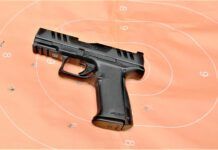

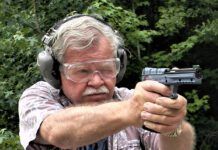

I have 2 PA HP22a, one with stock barrel and one with 5″. Love them both! Also have Baretta Tomcat (I realize different but similar) which I only tolerate as it’s finicky with ammo and barrel popping up unexpectedly.
Just want to say that 5 friends have fires HP22a and All bought one or say they will soo